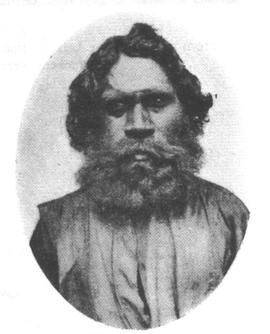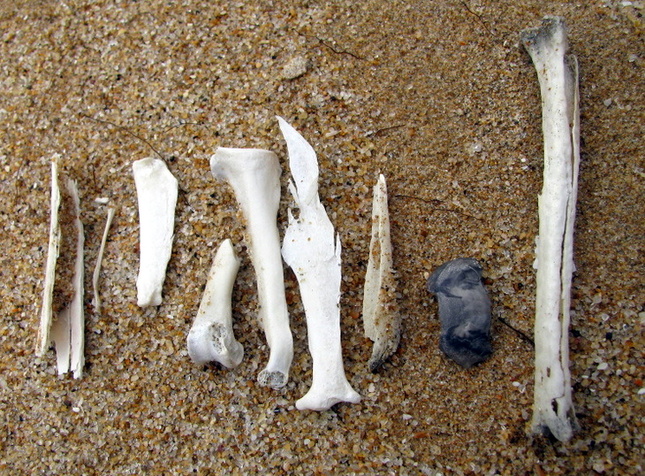
Warreners, Limpets, Chitons and and bullets - Point Nepean cultural artifacts. Click to enlarge
The Mornington Peninsula is particularly rich in aboriginal cultural heritage, with extensive coastal shell middens, particularly evident on the sandy Nepean Peninsula
On other parts, scar trees and stone tool sites are common and also vegetation communities of edible tuberous plants, once maintained by the women of the Boonwurrung clans, the Mayone-bulluk and Boonwurrung-balluk, that called the Mornington Peninsula home
Ever since 1802, when HMS Calcutta's Lieutenant Murray drove the Union Jack flagstaff through an ancient campsite's kitchen midden atop Sorrento's Point King (no doubt oblivious the future historical irony of the symbolism) traces of the peninsula's "Old People", as their descendents refer to them today, have been incrementally destroyed or just gently and gradually covered by the soil
Their hearths and homes, numerous when the first Europeans arrived, which unlike the stone houses of their cousins on the basalt plains to the west, were of sapling wood and bark and soon disappeared after they were moved off their country. See this page to read about that process and the Aboriginal Protectorate
But, things of stone, bone and shell persist (for many thousands of years) and these remains of campsites and aboriginal technology can often be seen where the ground has been excavated, eroded or otherwise disturbed
All artifact deposits are considered cultural sites and are protected under Victorian law
Indeed, known and undetected Aboriginal sites are protected by both State and Commonwealth legislation. Anyone who willfully disturbs or destroys Aboriginal sites can be fined AUD$10,000 and/or imprisoned for up to 5 years
See the peninsula maps below to see areas where special attention must be paid to the possibility of cultural site disturbance or destruction. Go to this page to download the guide, Ask first - Respecting Aboriginal Places
On other parts, scar trees and stone tool sites are common and also vegetation communities of edible tuberous plants, once maintained by the women of the Boonwurrung clans, the Mayone-bulluk and Boonwurrung-balluk, that called the Mornington Peninsula home
Ever since 1802, when HMS Calcutta's Lieutenant Murray drove the Union Jack flagstaff through an ancient campsite's kitchen midden atop Sorrento's Point King (no doubt oblivious the future historical irony of the symbolism) traces of the peninsula's "Old People", as their descendents refer to them today, have been incrementally destroyed or just gently and gradually covered by the soil
Their hearths and homes, numerous when the first Europeans arrived, which unlike the stone houses of their cousins on the basalt plains to the west, were of sapling wood and bark and soon disappeared after they were moved off their country. See this page to read about that process and the Aboriginal Protectorate
But, things of stone, bone and shell persist (for many thousands of years) and these remains of campsites and aboriginal technology can often be seen where the ground has been excavated, eroded or otherwise disturbed
All artifact deposits are considered cultural sites and are protected under Victorian law
Indeed, known and undetected Aboriginal sites are protected by both State and Commonwealth legislation. Anyone who willfully disturbs or destroys Aboriginal sites can be fined AUD$10,000 and/or imprisoned for up to 5 years
See the peninsula maps below to see areas where special attention must be paid to the possibility of cultural site disturbance or destruction. Go to this page to download the guide, Ask first - Respecting Aboriginal Places
The Old People

George of Arthurs Seat
Aboriginal people have lived and thrived in the Port Phillip region for tens of thousands of years (and still do) and it should be assumed that every excavation in undisturbed ground has the potential to turn up cultural artifacts
There is a convenient myth that all the First Australians were somehow nomads
They were no more nomadic than the contemporary Melbourne citizen with a house in the eastern suburbs and a foreshore campsite or holiday home on the peninsula and the occasional outing into the countryside to visit mum or stay with friends. Some campsites and middens have been used regularly/seasonally for hundreds or thousands of years
These people lived on the peninsula as a stable and continuous culture for more than the entire Holocene period, spanning the Eurasian concepts of the Upper Paleolithic, Mesolithic, Neolithic, Bronze, Iron, Middle and Modern ages and their tracks and traces deserve to be given the same respect as those of a similar antiquity in other parts of the world are afforded
See the maps and guides below to learn more about identifying cultural sites.....
See the Baluk Arts Boonwurrung history page here
Stone tools on a Dromana nature strip
Click the images to enlarge
Click the images to enlarge
selected artifact identification resources
from the AAV Aboriginal cultural heritage mini poster series
Coastal Shell Middens
Click on the page below to enlarge
| Aboriginal coastal shell middens fact sheet.pdf | |
| File Size: | 197 kb |
| File Type: | |
Stone Tools
Click on the page below to enlarge
Click on the page below to enlarge
| stone tools site identification.pdf | |
| File Size: | 163 kb |
| File Type: | |
Know your scar trees
Click on the page to enlarge
| scarred trees identification manual.pdf | |
| File Size: | 3943 kb |
| File Type: | |
An illustrated guide to Victorian coastal midden shell species
(middens are distinguished from other deposits of shells on the coasts by the fact that they exclusively contain certain edible species)
(middens are distinguished from other deposits of shells on the coasts by the fact that they exclusively contain certain edible species)
Click on the page to enlarge
| a guide to midden shells.pdf | |
| File Size: | 1056 kb |
| File Type: | |
Recording cultural sites

Midden material exposed by erosion on the ocean coast at Pt Nepean
If you know where there is a possible cultural site, such as a shell midden, hearth, stone quarry, stone arrangement, tool scatter or scar tree, you can report the find to Aboriginal Affairs Victoria for further investigation and registering
This may be important if the site is under some type of disturbance threat
The form below enables anyone to lodge a preliminary report with basic information about the site
| cultural site preliminary report form.pdf | |
| File Size: | 75 kb |
| File Type: | |


